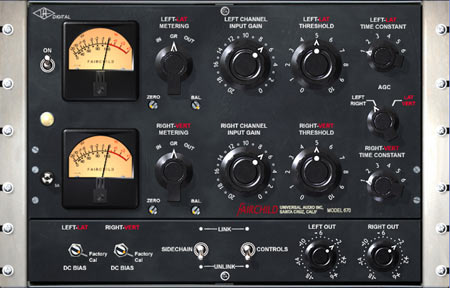Compression Obsession: Fairchild 670: Plugged in or Plug-In
The UA Fairchild 670 & 670M are coming very soon in v3.4 of UAD-1!
I was disappointed that I was unable to attend the measuring sessions with Dr. Dave [boo hoo, weren't we all... :-) -ed] at Ocean Way, where he used Allen Sides' favorite golden unit as the reference. At the follow-up listening test back at Ocean Way, three 670s were compared: The “golden” 670, our plug-in, and a second hardware 670. Rumor has it, picking out the second 670 was easy for Allen (like so many vintage pieces, sound can vary from unit to unit), but telling the difference between the golden unit and the plug-in was much harder. At any rate, I’ve gotten my hands on a pre-release copy of our plug-in 670, and it rocks! The 670 is a feature rich device, whether hardware or plug-in, and this month’s Compression Obsession delves deeper into the controls of the compressor. See
September’s “Compression Obsession” to get the rest of the Fairchild story.
 |
|
Fairchild 670M Mono Version
|
What’s New and Different
Obviously UA went to great efforts to capture the sonics of the 670 in our plug-in, but we also wanted to maintain all the functionality of the original design; only one change was made to the front panel controls: the meter select switch positions which were used to calibrate the meter on the original hardware are removed—consequently, the ‘zero’ screw-slot control is also disabled. This is of course because the meter never becomes uncalibrated on the plug-in. The positions on the switch are replaced with highly useful input and output level metering views.
UA included a separate aux panel which adds original rear access controls, common mods, or unique digital only additions:
- The DC bias controls are original controls, but were on the back of the hardware units
- The Sidechain Link control is a common mod, which had been done to the Ocean Way 670 we modeled
- The Controls Link is clearly a virtual-only addition, which allows linking of all seven dual controls
- The output level controls are also an addition for the plug-in, which allow make-up gain
 |
|
Fairchild 670
|
Singular Controls:
To link, or not to link
There are really two compressors within the Fairchild 670. The two channels can be used as dual L-R(dual mono), or lateral-vertical [or "lat-vert" for vinyl mastering]. If the ‘Sidechain Link’ mod has been added to the unit (like the one at Ocean Way), the two channels can be linked together to couple attack and release for the left and right or lat-vert signals.
The Controls Link switch will link all L-R controls for ease of L-R matching (plug-in only). If the controls are given an offset while unlinked, then when the link is engaged, the offset is preserved up to the range of travel of the linked controls.
AGC (Automatic Gain Control)
The mode in which the compressors operate is determined by the AGC (Automatic Gain Control) switch, and the Sidechain Link switch in the aux panel.
AGC is the selection between Left-Right or Lat-Vert. Normally, the user will likely use Left-Right on most occasions. But for interesting stereo image effects, try Lat-Vert on a stereo track or mix. Additionally, if one is mastering to vinyl, the Lat-Vert setting can be used to perform limiting prior to the encoding step, just as with the hardware 670. Let it be noted that with linked Lat-Vert, a transient that occurs in both channels will cause a bit more compression than a transient that only appears on left or right.
Paired Controls:
Metering allows the user to view Gain Reduction. As mentioned, the plug-in allows Input and Output views as well (plug-in only).
Balance controls bias current balance. The point of perfectly calibrated bias currents is achieved when the “dot” in the screw slot is at 12 o’clock. At this setting, the amount of additive signal deflection, or “thud”, which happens due to an attack, is minimized. Setting this control CCW from this position results in a thud of one polarity on transients, and going CW produces a thud of opposite sign.
Input Gain allows stepped control on the audio input. The steps are approximately 1dB apart, with approximately unity gain arriving at setting ‘18’.
Threshold is a continuously variable control for gain reduction. Turning CW gives more compression.
DC Bias controls knee of the compressor as well as the ratio. As the knob is turned CW, the ratio gets lower and the knee gets broader. The threshold also gets lower as the knob is turned CW. The ‘factory cal’ tick mark should be aligned with the screw slot “dot” for factory spec.
Left-Right Out is an addition to give the user stepped control of the final output stage, with each step being separated by 0.5 dB (plug-in only).
Time Constant is a stepped 6-position rotary switch, which adjusts Attack and Release times. Positions 1-4 give successively slower behavior, and 5 and 6 give program dependent response.

